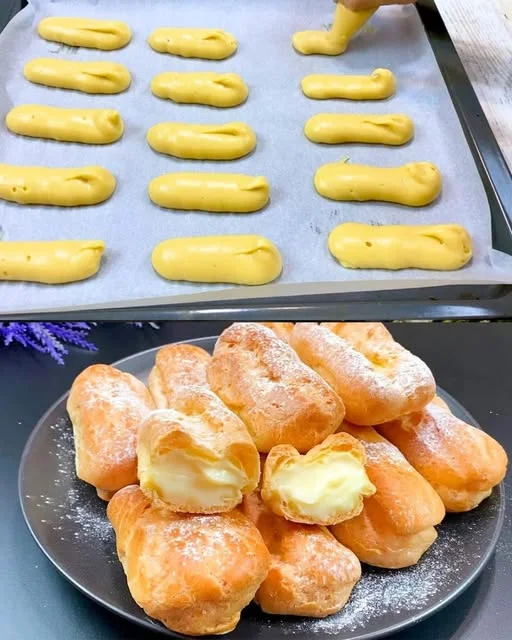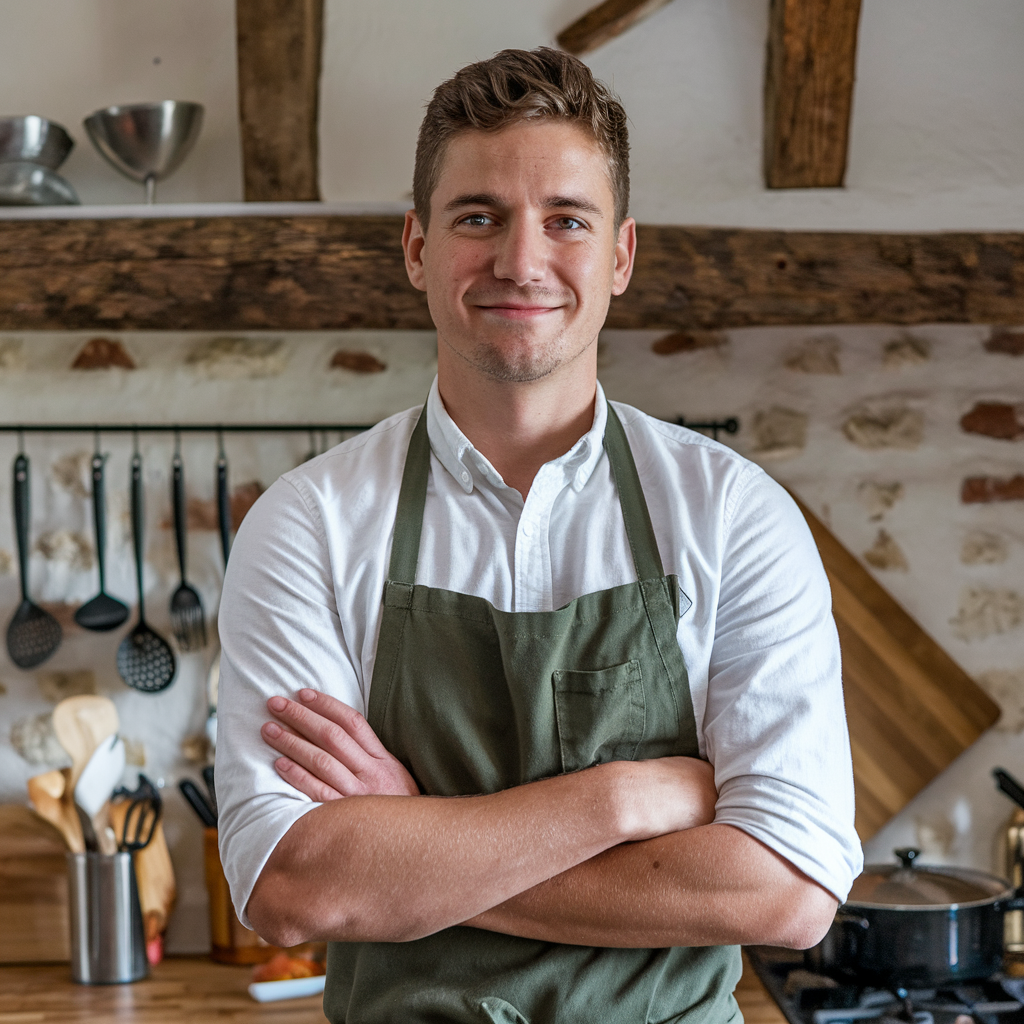The first time I made choux pastry, it was a complete disaster. I still remember staring at the flat, lifeless puffs that refused to rise, wondering what had gone wrong. My grandmother, an expert baker, stood beside me with a knowing smile. Instead of giving up, she guided me through the process again—watching the butter melt into the water, stirring in the flour until it came together, and slowly adding the eggs until the dough turned silky and glossy.
That day, as I pulled out my first batch of golden, crisp choux puffs, I understood what baking was truly about: patience, precision, and a bit of magic. Choux pastry isn’t just a recipe; it’s an experience. It’s the anticipation of watching the dough puff up in the oven, the joy of filling them with velvety cream, and the satisfaction of biting into a pastry so light it feels like a cloud.
Whether you are making éclairs, cream puffs, or profiteroles, mastering choux pastry is a skill every baker should embrace. This recipe is deceptively simple yet incredibly rewarding, offering endless possibilities for both sweet and savory creations.
The Science Behind the Perfect Choux Pastry
Choux pastry is unique because it doesn’t rely on baking powder or yeast for leavening. Instead, it harnesses the power of steam. The high moisture content in the dough turns into steam in the oven, causing the pastry to puff up beautifully. The key to success lies in the balance of ingredients and technique:
- Flour: Provides structure to the dough, allowing it to hold its shape.
- Butter & Water: Create the base, ensuring a rich flavor and correct moisture level.
- Eggs: The most crucial ingredient, as they give the dough its elasticity and allow it to expand properly in the oven.
Achieving the right consistency is vital. Too much egg and the dough becomes too runny, preventing the puffs from holding their shape. Too little, and they won’t rise properly. This is why adding eggs gradually is an essential step in perfecting choux pastry.
Ingredients
For the Choux Pastry
| Ingredient | Quantity |
|---|---|
| Water | 180g |
| Butter | 90g |
| Salt | A pinch |
| Sugar | A pinch |
| Flour | 130g |
| Eggs | 3-4 |
Directions
- Prepare the Dough
- In a saucepan, combine water, butter, salt, and sugar. Heat over medium flame until the butter fully melts and the mixture begins to simmer.
- Reduce heat to low and add the flour all at once. Stir vigorously with a wooden spoon until the dough pulls away from the sides of the pan and forms a smooth ball.
- Incorporate the Eggs
- Remove from heat and let the dough cool slightly for about 5 minutes.
- Add eggs one at a time, beating well after each addition until the mixture is glossy and smooth. The dough should be thick but still pipeable.
- Shape and Bake
- Preheat the oven to 200°C (390°F). Line a baking sheet with parchment paper.
- Transfer the choux pastry dough into a piping bag and pipe small mounds onto the baking sheet, leaving space between each.
- Bake for 20-25 minutes or until golden brown and puffed up. Avoid opening the oven door during baking to prevent deflation.
- Once baked, turn off the oven, crack the door open, and let the pastries cool inside for a few minutes to prevent collapse.
- Fill and Serve
- Once cooled, cut open and fill with pastry cream, whipped cream, or any filling of choice. Dust with powdered sugar or drizzle with chocolate for extra indulgence.
Nutritional Information
| Nutrient | Per 100g |
|---|---|
| Calories | 290 kcal |
| Carbohydrates | 25g |
| Protein | 6g |
| Fat | 19g |
| Sugar | 1g |
Common Mistakes and How to Avoid Them
Even experienced bakers sometimes struggle with choux pastry. Here are some common pitfalls and how to fix them:
1. Flat or Deflated Puffs
- This usually happens if the oven temperature is too low or if the dough is too runny. Make sure your oven is preheated properly, and add eggs gradually, stopping when the dough reaches the right consistency.
2. Cracked Pastry
- If your choux pastry cracks instead of forming a smooth shell, it may be due to too high oven temperature. Try baking at a consistent 200°C (390°F) and avoid sudden temperature changes.
3. Dough That Doesn’t Come Together
- If the dough seems lumpy or too stiff, it may not have been mixed properly after adding the flour. Stir vigorously until it forms a smooth ball before adding eggs.
4. Eggs Not Incorporating Properly
- If eggs don’t blend smoothly into the dough, it might be too hot. Allow the dough to cool slightly before adding eggs to prevent them from cooking prematurely.
Creative Variations of Choux Pastry
Once you’ve mastered the basic choux pastry, you can explore countless variations to make this dessert truly your own.
1. Chocolate Choux Pastry
Add 2 tablespoons of cocoa powder to the flour for a deep, rich chocolate flavor. Pair it with a chocolate mousse filling or coffee-infused cream for an indulgent treat.
2. Savory Choux Bites
Who says choux pastry is only for desserts? Skip the sugar and add cheese, herbs, or even finely chopped bacon to the dough for delicious savory puffs. Fill them with cream cheese, smoked salmon, or herbed butter for an elegant appetizer.
3. Choux au Craquelin
For extra crunch and a stunning visual appeal, top your choux puffs with a thin layer of craquelin—a dough made of butter, brown sugar, and flour. As it bakes, it forms a delicate, crackly crust, making each bite even more delightful.
4. Fruity Choux Delights
Infuse the pastry cream with fruit purees such as passion fruit, raspberry, or mango for a refreshing twist. Garnish with fresh berries and a dusting of powdered sugar for a sophisticated finish.
Frequently Asked Questions
Q1: Why does my choux pastry collapse after baking?
This usually happens if the pastries weren’t baked long enough. Choux pastry needs to be fully dry inside before being removed from the oven. To prevent collapse, bake them until they are deep golden brown and then let them cool inside the oven with the door slightly open.
Q2: Can I make choux pastry ahead of time?
Yes! You can make the dough a day in advance and store it in the refrigerator. Alternatively, baked choux pastries can be stored in an airtight container at room temperature for a day or frozen for up to a month. To refresh them, simply bake at 180°C (350°F) for a few minutes before serving.
Q3: Can I freeze choux pastry dough?
Yes, you can pipe the dough onto a baking sheet, freeze until firm, then transfer to an airtight container. Bake directly from frozen, adding a couple of extra minutes to the baking time.
Q4: How do I know when my choux pastry is ready for eggs?
After adding flour and stirring, the dough should form a smooth, shiny ball that pulls away from the sides of the pan. Let it cool slightly before adding eggs to avoid scrambling them.
Q5: What fillings pair well with choux pastry?
Classic choices include pastry cream, whipped cream, and chocolate ganache. For a creative twist, try flavored custards, mascarpone cream, or even ice cream for profiteroles.
Conclusion: A Recipe Worth Mastering
Choux pastry is more than just a baking technique—it’s an art form. With its delicate structure, crisp exterior, and airy interior, it is the foundation for some of the most beloved desserts. From the classic cream puff to decadent éclairs and gourmet variations, the possibilities are endless.
While it may seem intimidating at first, choux pastry is forgiving if you follow the right steps and understand the science behind it. Once you get the hang of it, you’ll find yourself returning to this recipe time and time again, experimenting with flavors and fillings to create your own signature treats.
So the next time you’re in the kitchen, take a deep breath, trust the process, and enjoy the magic of choux pastry. After all, every great baker starts with a few mistakes—but the reward is always worth it.

Heavenly Clouds: The Magic of Choux Pastry
Ingredients
Method
- Prepare the Dough: In a medium saucepan over medium heat, combine water, butter, salt, and sugar. Heat until the butter is fully melted and the mixture starts to simmer. Reduce the heat to low and add the flour all at once, stirring continuously with a wooden spoon until the dough forms a smooth ball and pulls away from the sides of the pan.
- Cool and Add Eggs: Remove the dough from heat and let it cool for about 5 minutes. Add eggs one at a time, mixing well after each addition, until the dough is smooth, glossy, and thick enough to hold its shape when piped.
- Pipe and Bake: Preheat the oven to 200°C (390°F) and line a baking sheet with parchment paper. Transfer the dough to a piping bag fitted with a round tip. Pipe small mounds onto the baking sheet, leaving space between each. Bake for 20-25 minutes, or until golden brown and puffed. Avoid opening the oven door while baking. Turn off the oven and leave the pastries inside with the door slightly open for a few minutes to prevent deflation.
- Fill and Serve: Once cooled, cut open and fill with pastry cream, whipped cream, or any desired filling. Dust with powdered sugar or drizzle with chocolate before serving.
Notes
- If the dough is too thick after adding three eggs, you may not need the fourth. The consistency should be smooth but not runny.
- Choux pastries can be stored in an airtight container at room temperature for a day or frozen for up to a month. To refresh, bake at 180°C (350°F) for a few minutes before serving.
- For extra crispy pastries, poke a small hole in each after baking to release excess steam.

